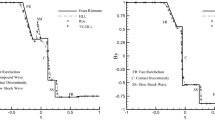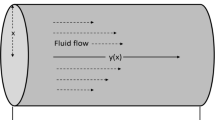Abstract
This paper presents an anisotropic adaptive finite element method (FEM) to solve the governing equations of steady magnetohydrodynamic (MHD) duct flow. A residual error estimator is presented for the standard FEM, and two-sided bounds on the error independent of the aspect ratio of meshes are provided. Based on the Zienkiewicz-Zhu estimates, a computable anisotropic error indicator and an implement anisotropic adaptive refinement for the MHD problem are derived at different values of the Hartmann number. The most distinguishing feature of the method is that the layer information from some directions is captured well such that the number of mesh vertices is dramatically reduced for a given level of accuracy. Thus, this approach is more suitable for approximating the layer problem at high Hartmann numbers. Numerical results show efficiency of the algorithm.
Similar content being viewed by others
References
Nesliturk, A. I. and Tezer-Sezgin, M. The finite element method for MHD flow at high Hartmann numbers. Comput. Methods Appl. Mech. Engrg., 194(9-11), 1201–1224 (2005)
Hsieh, P. W. and Yang, S. Y. A bubble-stabilized least-squares finite element method for steady MHD duct flow problems at high Hartmann numbers. J. Comput. Phys., 228(22), 8301–8320 (2009)
Hsieh, P. W., Shih, Y., and Yang, S. Y. A tailored finite point method for solving steady MHD duct flow problems with boundary layers. Commun. Comput. Phys., 10(1), 161–182 (2011)
Hosseinzadeh, H., Dehghan, M., and Mirzaei, D. The boundary elements method for magnetohydrodynamic (MHD) channel flows at high Hartmann numbers. Appl. Math. Model., 37(4), 2337–2351 (2013)
Zhang, L., Ouyang, J., and Zhang, X. The two-level element free Galerkin method for MHD flow at high Hartmann numbers. Phys. Lett. A, 372(35), 5625–5638 (2008)
Ainsworth, M. and Oden, J. T. A Posteriori Error Estimation in Finite Element Analysis, John Wiley & Sons, New York (2000)
Verfürth, R. A Review of a Posteriori Error Estimation and Adaptive Mesh-Refinement Techniques, Teubner-Wiley, Stuttgart (1996)
Kunert, G. A Posteriori Error Estimation for Anisotropic Tetrahedral and Triangular Finite Element Meshes, Ph. D. dissertation, Chemnitz Univesity of Technology (1999)
Kunert, G. A posteriori residual error estimator for the finite element method on anisotropic tetrahedral meshes. Numer. Math., 86(3), 471–490 (2000)
Kunert, G. A posteriori error estimation for convection dominated problems on anisotropic meshes. Math. Method. Appl. Sci., 26(7), 589–617 (2003)
Frey, P. J. and Alauzet, F. Anisotropic mesh adaptation for CFD computations. Comput. Methods Appl. Mech. Engrg., 194(48-49), 5068–5082 (2005)
Dolejší, V. Anisotropic mesh adaptation for finite volume and finite element methods on triangular meshes. Comput. Visual. Sci., 1(3), 165–178 (1998)
Apel, T. Anisotropic Finite Elements: Local Estimates and Applications, Teubner, Stuttgart (1999)
Chen, S. and Xiao, L. Interpolation theory of anisotropic finite elements and applications. Sci. China Ser. A, 51(8), 1361–1375 (2008)
Picasso, M. An anisotropic error indicator based on Zienkiewicz-Zhu error estimator: application to elliptic and parabolic problems. SIAM J. Sci. Comput., 24(4), 1328–1355 (2003)
Formaggia, L., Micheletti, S., and Perotto, S. Anisotropic mesh adaption in computational fluid dynamics: application to the advection-diffusion-reaction and the Stokes problems. Appl. Numer. Math., 51(4), 511–533 (2004)
Kuate, R. Anisotropic metrics for finite element meshes using a posteriori error estimates: Poisson and Stokes equations. Eng. Comput. -Germany, 29(4), 497–505 (2013)
Hecht, F., Pironneau, O., Morice, J., le Hyaric, A., and Ohtsuka, K. Freefem++ documentation, version 3.19-1. http://www.freefem.org/ff++ (2012)
Hecht, F. Bamg: bidimensional anisotropic mesh generator. http://www-rocq1.inria.fr/gamma/ cdrom/www/bamg/eng.htm (1998)
Scandiuzzi, R. and Schrefler, B. FEM in steady MHD duct flow problems. Int. J. Numer. Meth. Engrg., 30(4), 647–659 (1990)
Meir, A. Finite element analysis of magnetohydrodynamic pipe flow. Appl. Math. Comput., 57(2), 177–196 (1993)
Kay, D. The reliability of local error estimators for convection-diffusion equations. IMA J. Numer. Anal., 21(1), 107–122 (2001)
Verfürth, R. A posteriori error estimators for convection-diffusion equations. Numer. Math., 80(4), 641–663 (1998)
Babuška, I., Strouboulis, T., Upadhyay, C. S., Gangaraj, S. K., and Copps, K. Validation of a posteriori error estimators by numerical approach. Int. J. Numer. Meth. Engrg., 37(7), 1073–1123 (1994)
Chen, H., Chen, S., and Qiao, Z. C0-nonconforming tetrahedral and cuboid elements for the three-dimensional fourth order elliptic problem. Numer. Math., 124(1), 99–119 (2013)
Chen, H. R., Chen, S. C., and Qiao, Z. H. C0-nonconforming triangular prism elements for the three-dimensional fourth order elliptic problem. J. Sci. Comput., 55(3), 645–658 (2013)
Chen, H. and Chen, S. Uniformly convergent nonconforming element for 3-D fourth order elliptic singular perturbation problem. J. Comput. Math., 32(6), 687–695 (2014)
Author information
Authors and Affiliations
Corresponding author
Additional information
Project supported by the National Natural Science Foundation of China (Nos. 11471329, 11321061, and 91430215), the National Magnetic Confinement Fusion Science Program of China (No. 2015GB110000), the Youth Innovation Promotion Association of Chinese Academy of Sciences (CAS) (No. 2016003), and the National Center for Mathematics and Interdisciplinary Sciences of CAS
Rights and permissions
About this article
Cite this article
Zhao, J., Mao, S. & Zheng, W. Anisotropic adaptive finite element method for magnetohydrodynamic flow at high Hartmann numbers. Appl. Math. Mech.-Engl. Ed. 37, 1479–1500 (2016). https://doi.org/10.1007/s10483-016-2107-9
Received:
Revised:
Published:
Issue Date:
DOI: https://doi.org/10.1007/s10483-016-2107-9
Keywords
- magnetohydrodynamic (MHD) flow
- posteriori error estimate
- anisotropic adaptive finite element method (FEM)




